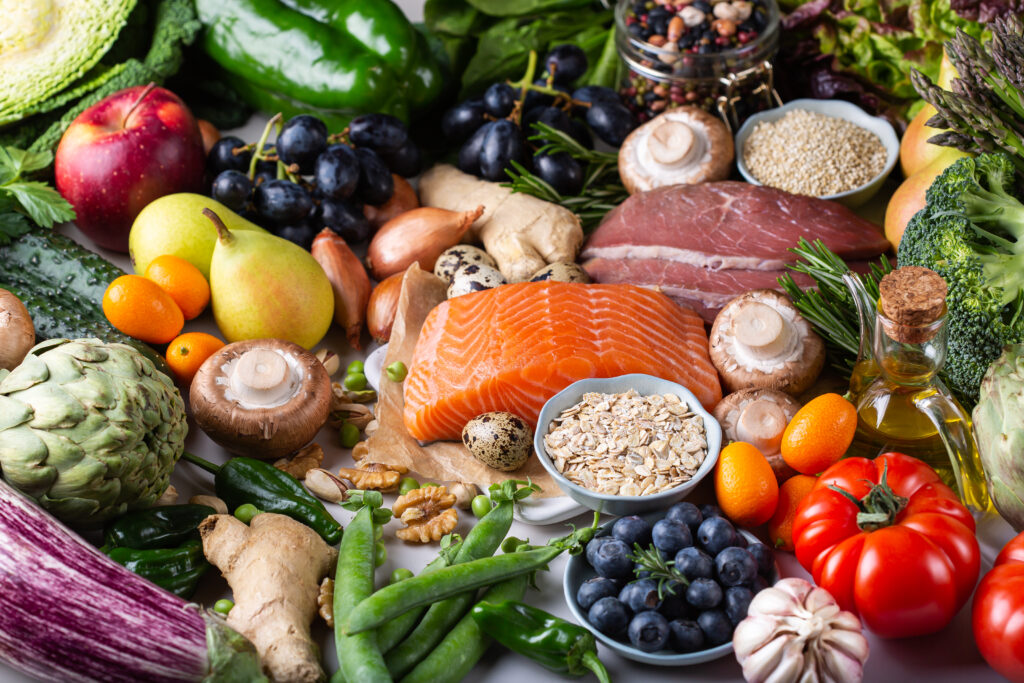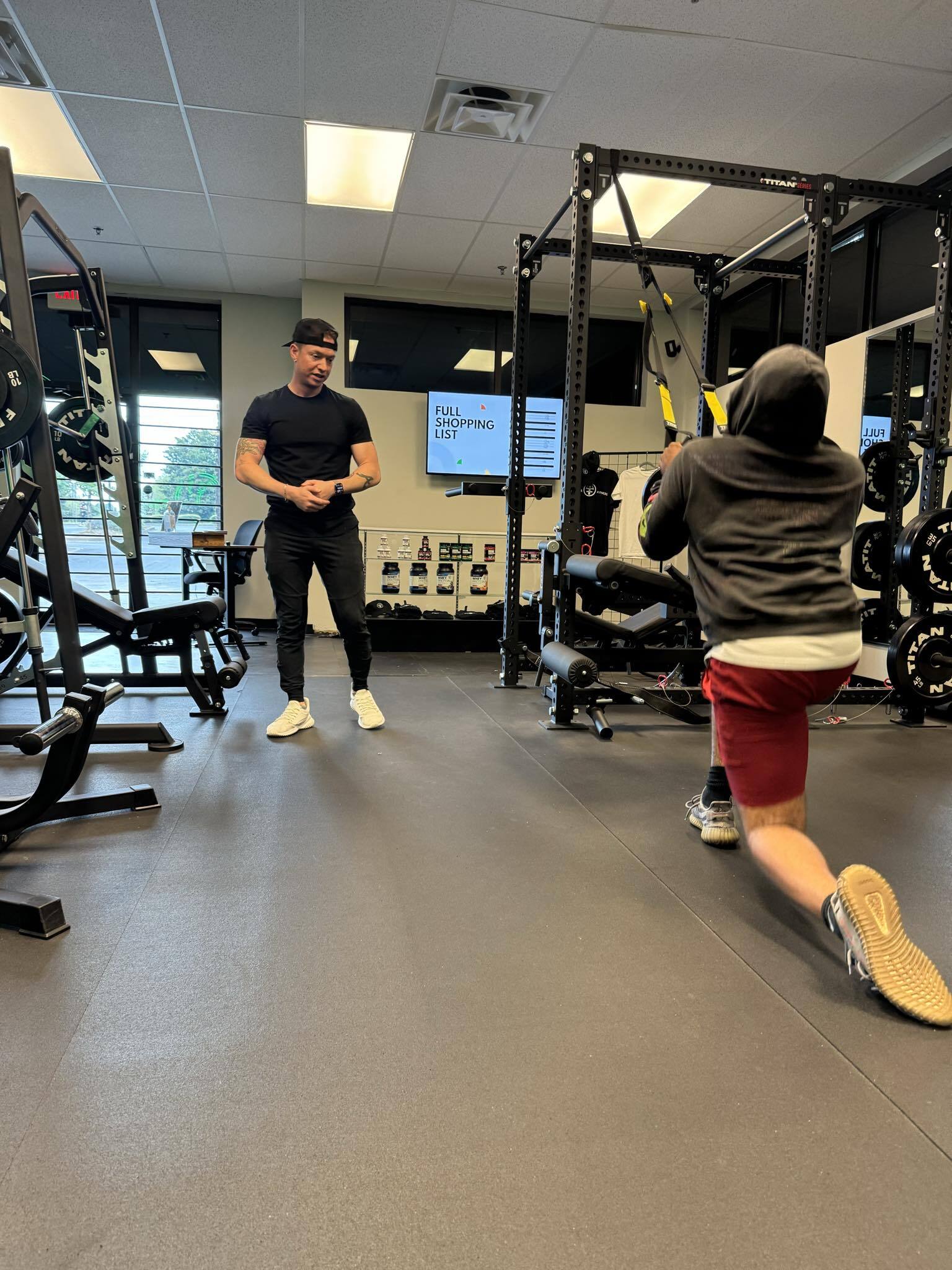Welcome to our comprehensive guide on efficient weight loss tips and strategies to help you achieve your fitness goals. Whether you’re looking to shed a few pounds or embark on a major body transformation, this article will provide you with valuable insights on how to lose weight effectively.

When it comes to weight loss, there is no one-size-fits-all solution. It’s important to approach your journey with a customized plan that suits your unique needs. In this article, we will explore the importance of diet plans, healthy eating, and exercise routines in achieving sustainable weight loss.
Key Takeaways:
- Focus on creating a balanced diet plan that includes all necessary nutrients.
- Incorporate regular exercise routines to burn calories and increase metabolism.
- Set realistic goals to stay motivated and track your progress.
- Develop a healthy relationship with food and make sustainable changes to your eating habits.
- Seek support from friends, family, or a weight loss community to stay accountable.
Setting Realistic Goals
Before embarking on your weight loss journey, it’s imperative to set realistic goals that will guide you along the way. Setting attainable targets is key to staying motivated and focused on your fitness journey. Additionally, understanding the importance of weight management plays a crucial role in achieving long-term success.
When it comes to weight loss, it’s important to remember that it’s not just about a number on the scale. Your fitness journey should focus on sustainable changes that promote overall well-being and a healthier lifestyle. Setting achievable goals allows you to make progress at a pace that is suitable for your body and reduces the risk of disappointment or burnout.
“Setting realistic goals is the first step in turning the invisible into the visible.” – Tony Robbins
By establishing realistic goals, you create a roadmap for success. It’s essential to set targets that are specific, measurable, attainable, relevant, and time-bound (SMART goals). For example, instead of aiming to lose an unrealistic amount of weight in a short period, a more achievable goal might be to lose 1-2 pounds per week through a combination of healthy eating and regular exercise.
When setting your weight loss goals, consider factors such as your current weight, fitness level, and overall health. Consult with a healthcare professional or a registered dietitian to determine a healthy weight range for your body. They can provide personalized guidance based on your unique needs and circumstances.
Remember, weight management is not just about reaching a certain number; it’s about developing a sustainable lifestyle that supports your overall well-being. Focus on incorporating healthy habits into your daily routine, such as nourishing your body with nutritious foods, staying physically active, and taking care of your mental health.
Setting realistic goals and prioritizing weight management will empower you to make positive changes and embrace a healthier lifestyle. Stay motivated, celebrate small victories along the way, and never lose sight of the long-term benefits you’ll achieve on your weight loss journey.
Tips for Setting Realistic Goals:
- Start by assessing your current weight, health condition, and fitness level.
- Consult with a healthcare professional or a registered dietitian for personalized guidance.
- Set specific, measurable, achievable, relevant, and time-bound (SMART) goals.
- Focus on overall well-being and sustainable lifestyle changes rather than just a number on the scale.
- Celebrate small victories and stay motivated throughout your fitness journey.
Creating a Balanced Diet Plan
Achieving sustainable weight loss requires a balanced diet plan that nourishes your body with the necessary nutrients. By focusing on healthy eating habits and portion control, you can support your weight loss efforts and improve your overall well-being.
Here are some tips to help you create a nutritious meal plan:
Include a Variety of Nutrient-Dense Foods
When designing your diet plan, prioritize nutrient-dense foods that provide the essential vitamins, minerals, and antioxidants your body needs for optimal functioning. Include a diverse range of fruits, vegetables, whole grains, lean proteins, and healthy fats to ensure you’re getting a wide array of nutrients.
Practice Portion Control
Controlling your portion sizes is crucial for managing calorie intake and promoting weight loss. Use smaller plates and bowls to help control serving sizes, and aim to fill half your plate with vegetables, one-quarter with lean protein, and one-quarter with whole grains or healthy carbohydrates.
Make Healthier Food Choices
Swap out processed and sugary foods for healthier alternatives. Choose whole foods over processed options, opt for lean proteins like chicken, fish, or tofu, and replace sugary drinks with water or herbal tea. Making healthier food choices can help reduce calorie intake and support your weight loss goals.
Remember, it’s essential to consult with a healthcare professional or registered dietitian when creating a diet plan tailored to your specific needs and goals.

“The food you eat can be either the safest and most powerful form of medicine or the slowest form of poison.” – Ann Wigmore
Incorporating Regular Exercise Routines
Regular exercise is crucial for weight loss and overall health. It not only helps you shed those extra pounds but also improves your cardiovascular fitness and boosts your mood. Finding the right exercise routine that suits your goals and preferences is key to sticking with it and making it a consistent part of your fitness journey.
When it comes to weight loss, different types of exercise routines can be effective in burning calories, building muscle, and increasing your metabolism. Here are some popular options to consider:
- Cardiovascular exercises: These exercises, such as running, cycling, or swimming, help you burn a significant number of calories and improve your heart health. Aim for moderate to high-intensity workouts for at least 150 minutes per week to maximize weight loss benefits.
- Strength training: Incorporating strength training exercises, such as lifting weights or using resistance bands, can help you build lean muscle mass. Muscles burn more calories than fat, even at rest, so increasing your muscle mass can contribute to a higher metabolism.
- High-intensity interval training (HIIT): HIIT workouts involve short bursts of intense exercises followed by active recovery periods. These workouts are time-efficient and can help you burn calories during and after the workout.
- Group fitness classes: Joining group fitness classes, such as Zumba, kickboxing, or spinning, can make exercise more enjoyable and motivate you to stay consistent. It also provides an opportunity to socialize and meet like-minded individuals.
- Outdoor activities: Engaging in activities like hiking, swimming, or playing a sport not only helps you burn calories but also allows you to enjoy the great outdoors while staying active.
Remember, finding an exercise routine that you enjoy will increase your chances of sticking with it in the long run. To stay motivated and make exercise a consistent part of your fitness journey, consider the following tips:
- Set realistic goals: Start with small, achievable goals and gradually increase the intensity and duration of your workouts.
- Find a workout buddy: Exercising with a friend or family member can make workouts more enjoyable and hold you accountable.
- Vary your routine: Mix up your workouts to prevent boredom and challenge your body in different ways.
- Track your progress: Keep a record of your workouts, monitor your improvements, and celebrate your achievements along the way.
- Stay consistent: Make exercise a habit by scheduling it into your daily routine and treating it as a non-negotiable commitment to yourself.
Remember to consult with a healthcare professional before starting any new exercise routine, particularly if you have any pre-existing medical conditions or concerns.
Benefits of Regular Exercise for Weight Loss
Regular exercise offers numerous benefits beyond weight loss alone. Here are some additional advantages of incorporating exercise into your weight loss journey:
- Improved cardiovascular health: Exercise helps strengthen your heart and improves blood circulation, reducing the risk of heart disease and other cardiovascular conditions.
- Increased energy levels: Regular physical activity boosts energy levels and combats feelings of fatigue and lethargy.
- Enhanced mood and mental well-being: Exercise stimulates the release of endorphins, also known as “feel-good” hormones, which can improve your mood and reduce symptoms of anxiety and depression.
- Better sleep quality: Engaging in regular exercise promotes better sleep, helping you feel refreshed and rejuvenated.
- Reduced risk of chronic diseases: Exercise can lower the risk of developing chronic conditions such as type 2 diabetes, certain types of cancer, and osteoporosis.
Now that you know the importance of regular exercise for weight loss and overall health, it’s time to lace up those sneakers and get moving!
Understanding the Role of Healthy Eating
When it comes to weight loss, healthy eating plays a crucial role in shaping your success. By incorporating nutrient-dense foods into your diet, you can fuel your body with the right nutrients while shedding unwanted pounds. Let’s dive deeper into the importance of healthy eating and discover the key elements of a slimming program.
First and foremost, focus on adding a variety of fruits and vegetables to your meals. These colorful and fiber-rich options not only provide essential vitamins and minerals but also promote satiety, keeping you full for longer periods. Incorporating lean proteins, such as chicken, fish, and tofu, can further support your weight loss efforts by helping to build and maintain muscle mass.
Including whole grains in your diet is another crucial aspect of healthy eating. Whole grains, such as quinoa, brown rice, and whole wheat bread, are packed with fiber and can help regulate your blood sugar levels, keeping cravings at bay. Additionally, healthy fats, like those found in avocados, nuts, and olive oil, can provide a feeling of satisfaction and contribute to overall heart health.
To make sustainable changes to your eating habits, it’s important to approach food with a balanced and mindful mindset. Rather than following restrictive diets or depriving yourself, aim for moderation and portion control. Listen to your body’s hunger and fullness cues, and honor them accordingly. Avoid labeling certain foods as “good” or “bad” and instead focus on nourishing your body with wholesome choices.
Remember, healthy eating is not a short-term solution but a lifelong journey. Embrace the power of nutritious foods, and you’ll not only achieve your weight loss goals but also develop a positive relationship with food.
Key Elements of a Slimming Program:
- Incorporate fruits and vegetables for essential vitamins and minerals
- Add lean proteins to build and maintain muscle mass
- Include whole grains for fiber and balanced blood sugar levels
- Integrate healthy fats for satisfaction and heart health
- Practice moderation and portion control
By understanding the role of healthy eating in your weight loss journey, you can create a solid foundation for long-term success. Remember, every small step you take towards a healthier diet brings you closer to your desired goals.
| Benefit | Examples |
|---|---|
| Essential Vitamins & Minerals | Fruits, vegetables |
| Muscle Building | Chicken, fish, tofu |
| Regulated Blood Sugar | Quinoa, brown rice, whole wheat bread |
| Satisfaction & Heart Health | Avocados, nuts, olive oil |
Overcoming Common Weight Loss Challenges
Embarking on a weight loss journey can be challenging, and it’s important to recognize that setbacks and obstacles are normal along the way. In this section, we will address some common challenges faced by individuals striving to lose weight and provide practical strategies to overcome them. By equipping yourself with the right knowledge and mindset, you can stay motivated and focused on reaching your weight loss goals.
The Plateau Effect
One of the most frustrating challenges during a weight loss journey is hitting a plateau. It’s when the scale stops moving, despite your consistent efforts. Remember, weight loss is not always linear, and plateaus are a natural part of the process. However, there are strategies to overcome this hurdle and continue progressing towards your goals:
- Reassess and modify your exercise routine: Introduce new exercises, increase intensity, or switch up your workout routine to challenge your body.
- Adjust your calorie intake: As you lose weight, your body’s caloric needs may change. Recalculate your daily caloric intake and make slight adjustments if needed.
- Stay consistent: Plateaus can be discouraging, but remain committed and consistent with your healthy eating habits and exercise routine. Remember, small positive changes over time add up to significant results.
Craving Management
Dealing with cravings is another common challenge when trying to lose weight. Here are some effective strategies to manage cravings:
- Find healthier alternatives: Instead of indulging in unhealthy snacks, find satisfying alternatives that are lower in calories but still enjoyable.
- Practice mindful eating: Pay attention to physical hunger cues and practice portion control. Slow down while eating, savor each bite, and listen to your body’s signals of fullness.
- Stay hydrated: Often, thirst can be mistaken for hunger. Drink plenty of water throughout the day to stay hydrated and curb unnecessary cravings.
Maintaining Motivation
Keeping your motivation levels high throughout your fitness journey is crucial for long-term success. Here are some strategies to stay motivated:
Celebrate your achievements, no matter how small—they all contribute to your progress and deserve recognition.
- Set milestones: Break your weight loss goals into smaller, achievable milestones. Celebrate each milestone reached, giving yourself a sense of accomplishment and motivation to keep going.
- Stay inspired: Surround yourself with positive influences, whether it’s through inspiring quotes, success stories of others who have achieved weight loss, or finding a support group.
- Practice self-compassion: Weight loss journeys can have ups and downs. Be kind to yourself, acknowledge setbacks, and focus on getting back on track rather than dwelling on them.
By applying these strategies, you’ll be equipped to tackle common challenges along your weight loss journey and stay motivated on your path to a healthier and fitter you.
Tracking Progress and Staying Accountable
Tracking your progress is crucial to keeping yourself motivated and accountable throughout your weight loss journey. By monitoring your achievements and challenges, you can make adjustments as needed and stay on track towards your body transformation goals.

There are several effective methods you can use to track your weight loss progress:
- Recording Measurements: Take regular measurements of your body, including your weight, waist circumference, hip circumference, and body fat percentage. This will allow you to see tangible changes and track your progress over time.
- Taking Progress Photos: Snap photos of yourself at the beginning of your fitness journey and periodically throughout. Compare these photos side by side to visually see the changes in your body shape and size.
- Keeping a Food and Exercise Journal: Maintain a detailed record of the food you consume and the exercises you perform. This will help you identify any patterns or areas of improvement, enabling you to make necessary adjustments and keep yourself accountable.
Staying accountable to your weight loss goals also involves seeking support from others. Connecting with a weight loss community, friends, or family members who are invested in your fitness journey can provide encouragement, motivation, and valuable insights.
“Surround yourself with people who believe in your dreams and empower your weight loss journey. Support and accountability are key to your success.” – Jane Doe, Fitness Enthusiast
Track Your Progress Table
| Method | Description |
|---|---|
| Recording Measurements | Regularly measure your weight, waist circumference, hip circumference, and body fat percentage to track your physical changes. |
| Taking Progress Photos | Document your body’s transformation by taking photos periodically to visually observe the changes in your physique. |
| Keeping a Food and Exercise Journal | Maintain a record of your food intake and exercise routines to analyze your habits, identify areas for improvement, and hold yourself accountable. |
Remember, consistent tracking and staying accountable throughout your weight loss journey will help you stay focused, motivated, and achieve the body transformation you desire.
Conclusion
In conclusion, achieving efficient weight loss and body transformation requires a holistic approach. By following personalized diet plans, adopting healthy eating habits, and incorporating regular exercise routines into your lifestyle, you can attain sustainable results and create lasting positive changes in your body and overall well-being.
Setting realistic goals is crucial to stay motivated and focused on your fitness journey. It’s important to create a balanced diet plan that includes nutrient-dense foods and emphasizes portion control. Additionally, staying consistent with your exercise routine is key to maximizing calorie burn, building muscle, and boosting your metabolism for optimal weight loss.
Remember, weight loss is not just about the numbers on the scale, but also about improving your overall health and achieving a healthier, happier life. Embrace the opportunity to start your weight loss journey today, armed with knowledge and determination. With dedication and perseverance, you can reach your goals and experience a transformative body and mind.
FAQ
What are some efficient weight loss tips and strategies?
Efficient weight loss tips include following a balanced diet plan, incorporating regular exercise routines, and setting realistic goals. It’s important to focus on healthy eating and find an exercise routine that works for you.
How can I set realistic weight loss goals?
Setting realistic weight loss goals is crucial for success. Start by assessing your current weight, body composition, and overall health. Consult with a healthcare professional or a certified fitness trainer who can help you set attainable targets based on your individual needs and time frame.
What should a balanced diet plan include?
A balanced diet plan should include a variety of nutrient-dense foods such as fruits, vegetables, lean proteins, whole grains, and healthy fats. It’s important to practice portion control and make healthier food choices to support weight loss and overall health.
How often should I exercise for weight loss?
For weight loss, it’s recommended to engage in at least 150 minutes of moderate-intensity aerobic exercise or 75 minutes of vigorous-intensity aerobic exercise per week. Additionally, incorporating strength training exercises at least two days a week can help build muscle and boost metabolism.
How can I overcome common weight loss challenges?
Common weight loss challenges include plateaus, cravings, and lack of motivation. To overcome these, it’s important to stay consistent, vary your exercise routine, manage stress, and seek support from friends, family, or a weight loss community.
How do I track my progress during my weight loss journey?
Tracking progress can help you stay motivated and accountable. You can track your weight loss journey by recording measurements, taking progress photos, keeping a food and exercise journal, or using mobile apps and fitness trackers. Find a method that works best for you.
What is the key to achieving a body transformation?
The key to achieving a body transformation is a combination of a balanced diet plan, regular exercise routines, and consistency. By making sustainable changes to your eating habits, staying committed to your fitness journey, and seeking support, you can achieve your desired body transformation.

What are Somatic Exercises? A Guide for Beginners
In today’s fast-paced world, feeling disconnected from our bodies is easy. We spend hours hunched over screens, rushing from one commitment to the next, often

Personal Fitness Trainer Near Me | Certified Fitness Coach in Duluth, GA
Are you tired of feeling lost in the vast world of fitness? Do you yearn for personalized guidance, unwavering support, and a roadmap to achieve

The Ultimate Protein Guide for Muscle Growth: Science-Backed Tips to Maximize Your Gains
Everyone’s talking about protein these days, and for good reason. Nearly one in three older Americans needs to consume more protein. This essential nutrient is
